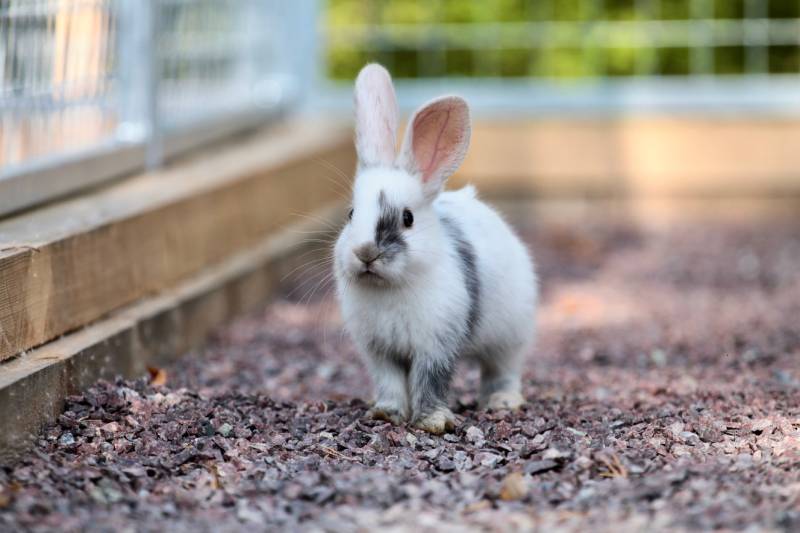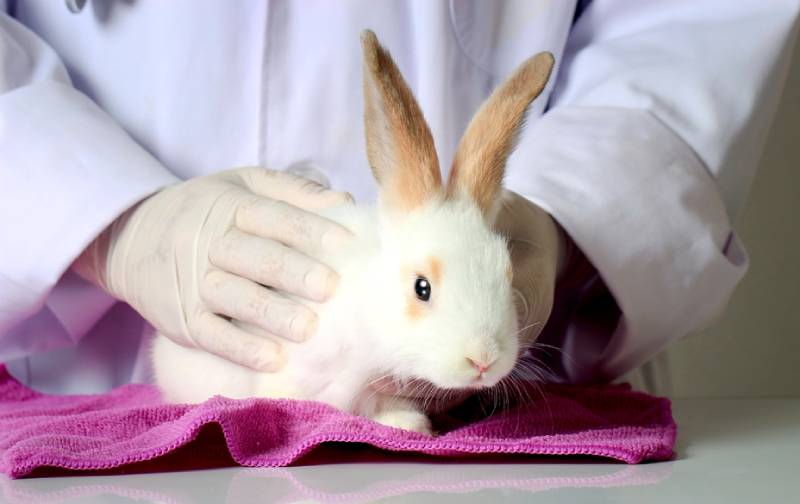Why Is My Rabbit Shedding So Much? 15 Likely Reasons

Updated on

Click to Skip Ahead
Like most animals with fur, rabbits shed that fur at various times throughout their lives. The technical term is molting. If your rabbit sheds occasionally, that’s perfectly normal and nothing to worry about. However, if you notice that your rabbit is suddenly shedding more than usual or their fur is starting to look “patchy” in places, that’s often a sign that your rabbit isn’t feeling well and needs veterinary care.
If you’re worried about your whiskered fur baby because their fur seems to be thinning rapidly, we’ll discuss 15 different reasons, broken into three sections, why this might be occurring, how to help and when your rabbit needs to be seen by a vet.
The 4 Normal Reasons Your Rabbit Is Shedding
1. It’s Springtime.
Rabbits in the wild shed twice a year, in spring and autumn. Domestic rabbits may establish their own molting patterns, shedding 3-4 times per year or continuously throughout the year, but they usually shed most noticeably in spring. That’s when a rabbit will be busy getting rid of their heavy winter coat. Again, this is 100% normal and nothing to worry about. Some rabbits will be shedding for weeks, or even as long as 3-4 months.
2. Your rabbit is a baby or has just hit 4 or 5 months of age.
Rabbits go through several shedding patterns throughout their life. Soon after weaning at 4-6 weeks of age, the initial soft baby coat gradually starts to be replaced by a thicker intermediate coat. The first time the regular adult molting pattern begins is the most noticeable because the majority of rabbits will be 4 or 5 months old when it happens and thus still quite small. For giant breeds, this happens at around 6-9 months of age. At this point in their life, a rabbit will shed their baby and intermediate fur, and it will be gradually replaced by adult fur.

3. Your Rabbit May Have a Condition Called “Coat Blow”.
Coat blow is an infrequently described condition where vast amounts of fur start shedding from your bunny, and in some cases, they will develop small bald patches 1. Thankfully, this is normal in most cases, and usually, a new coat will begin growing right away. Coat blow isn’t often seen in rabbits, but it does happen. However, if your bunny’s skin stays bare or starts to look red, inflamed, or irritated, a visit to your local vet is recommended. Irritated, bald skin is likely a sign of illness.
4. Your Rabbit’s Molting Has Just Begun
When rabbits molt in normal circumstances, they typically start by shedding fur from their head. The shedding then spreads down the neck and back, then down the sides of their body, and finishes on their rump. So if your rabbit seems generally healthy and you have noticed shedding starting on their head, it might be a sign their molting has begun. If there is any doubt about your rabbit’s health, it is best to get them checked out by your vet promptly, as many illnesses in rabbits progress rapidly and some can be very painful and life threatening.

The 4 Housing, Environment & Stress Reasons Your Rabbit Is Shedding:
1. The Enclosure or Environment Fluctuates Too Much
Inadequate enclosure type and environment may also cause your rabbit to shed excessively or constantly. If the enclosure is placed in a room or area that frequently has draft fluctuations, the rabbit will likely shed inconsistently all year round in irregular patterns, rather than seasonally.
2. Your Rabbit May Be Stressed
Domestic rabbits can get stressed out and anxious quite easily. Wild rabbits live in holes in the ground, where it’s always dark, and are active at dawn and dusk. In your home, where there’s a lot of light, overexposure could add another stressor. Stress can cause your rabbit to shed a lot more than usual. One way to help is to give your rabbit a dark hiding place to rest during the day. Also, if there’s a lot of commotion, noise, or other pets in your home, move your rabbit to a room away from the chaos and any “predator” type pets, such as dogs and cats.

3. Your Rabbit May Be Overcrowded or Bullied
Compulsive hair chewing (barbering) and over-grooming are abnormal behaviors causing bald patches, usually related to stress due to overcrowding and bullying or as a result of inadequate diet with insufficient fiber. Rabbits are territorial animals, and at times, a new rabbit might be bullied by existing rabbits, and they will barber the newcomer. Heavily pregnant does may also exhibit aggressive behavior. If aggression happens between rabbits, it’s best to separate them to prevent injuries and stress.
4. Your Rabbit Is Pregnant and Nesting
Pregnant female rabbits (does) may pull out their own hair from the stomach, chest, and flank areas. This fine hair is used to line the burrow before giving birth. Does are more likely to pull large quantities of hair if they are stressed or if there is not enough quality nesting material present. Similar hormonal changes in a doe with a false pregnancy can cause the same behavior.

The 7 Illness or Infection Reasons Your Rabbit Might Be Shedding:
1. Your Rabbit May Have a Skin Infection
Skin infections, most often bacterial, can lead to abnormal or excessive molting in rabbits, alongside other signs. Rabbits living in warm and humid climates, as well as those that are unable to groom themselves efficiently (often due to pain, arthritis, obesity or illness) are particularly susceptible to bacterial skin infections. Moisture from the environment or the rabbit’s urine and feces collects in the fur and on the skin, especially around the hindquarters, tail, and thighs where the rabbit cannot easily reach. The skin becomes friable, smelly, inflamed, and infected. This can worsen and lead to fly strike.
2. Your Rabbit May Have Myxomatosis
Myxomatosis is a deadly viral illness in rabbits that also affects the skin, but the signs usually involve skin lumps and swelling around the eyes and genitals, often ulcerated and weepy, rather than shedding. It spreads via contact with wild rabbits or from mosquito and flea bites. Unfortunately, myxomatosis is almost always fatal, often within days of discovering first signs, and the virus has no cure. When it happens, your bunny will rapidly undergo extreme health changes, some of which may include changes to their fur.

3. Your Rabbit May Have an External Parasite
Many external parasites can cause abnormal shedding in rabbits, and this will often lead to thinning of the coat, fur loss with bald patches, skin irritation, and sometimes infection. Some rabbits might be particularly itchy and will scratch, causing further skin sores and alopecia. Some of these parasites include fleas, mites, lice, and maggots. These infestations can also be associated with skin wounds, discharge, bad smell, or a mucky bottom. Some of these tiny little critters can be seen by the naked eye on your bunny, and some can be transmitted to people, leading to significant skin irritation and itchiness.
4. Your Rabbit May Have Ringworm
Ringworm is a fungal disease that can affect not only your rabbit, but also people and other pets, such as cats and dogs. It’s very contagious, and spores can survive in the environment for months or even years. Affected rabbits have patches of hair loss and crusty, scaly skin, especially on their face, eyes, nose, and limbs, sometimes with ulcers. Rabbits who are stressed or unwell for other reasons are also susceptible to infection.
5. Your Rabbit May Have a Tear Duct Problem
Sometimes rabbits may be shedding more than usual but only around their eyes. If this is the case, the problem might be that something is affecting their eyes and, more specifically, their tear ducts. For example, if your rabbit’s upper teeth are growing long roots, it can impact the tear ducts and cause them to water more than normal.

6. Your Rabbit May Have an Eye Infection
Eye infections can cause the same problem, and the tears can cause the fur around your rabbit’s eyes to shed heavily. A blocked tear duct can cause the problem, too, as well as a respiratory infection. Whatever the cause, taking your rabbit to the vet to treat its eye condition is vital. Fur loss around the mouth and chin, or fur becoming sticky and wet, might be a sign of dental disease in your rabbit that needs prompt veterinary attention.
7. Your Rabbit May Have an Autoimmune Disorder or Other Health Problem
Autoimmune disorders, nutritional deficiencies, tumors, and side effects from medications can all result in multiple or larger areas of hair loss that resemble excessive shedding. All of these require your vet’s attention.
All of these disorders and illnesses might cause abnormal fur loss, also called alopecia. What’s important to understand is that alopecia is a sign rather than an actual disease. If your rabbit has alopecia for any of the above reasons, a visit to your local vet is warranted immediately to determine what’s causing it and to treat the cause, not just the sign. Many of these disorders cause a serious and life-threatening illness if not treated promptly.
Balanced nutrition, regular grooming, and a clean rabbit pen are essential to prevent and notice early signs of parasitic and other skin conditions or general illnesses. Contact your vet immediately if you think your rabbit is ill or might have a skin irritation or parasites that are causing their excessive shedding. Never apply flea treatment intended for dogs and cats to your rabbit, as this can be poisonous. Overweight, sick, pained, or arthritic bunnies can’t groom themselves well to keep the mite population under control. If your rabbit gets a mite infestation, your vet will examine them thoroughly for an underlying illness that might be preventing their immune system from keeping the mites under control.

Will Brushing Help My Rabbit When They Shed?
It’s recommended to brush short-haired rabbits several times a week and long-haired rabbits daily. Brushing is also vital when your rabbit is shedding to help them shed their old fur faster. Always be gentle and never force the fur to come out if it is not loose.
Not only does brushing help your rabbit shed, but it also keeps their fur clean. Yes, they clean themselves, but some parts of their bodies are difficult for rabbits to reach. Long-haired breeds may require brushing more than once a day.
Final Thoughts
If you were wondering why your rabbit was shedding so much, you now know that there are a few possible reasons, and some of them will require appropriate and prompt treatment from your vet. Rabbits can sometimes molt constantly, but this is usually most obvious in the spring and autumn. They also shed for the first time at 4 or 5 months old on average, depending on their breed, in order to replace their baby and intermediate fur with adult fur.
If your rabbit is suddenly shedding excessively, you should assume something is wrong. Your pet might be stressed, anxious, or suffering from one of many possible underlying diseases. The tips we gave above should help with stress, but visiting your vet will be necessary for anything else.
Featured Image Credit: Irina Kozorog, Shutterstock











